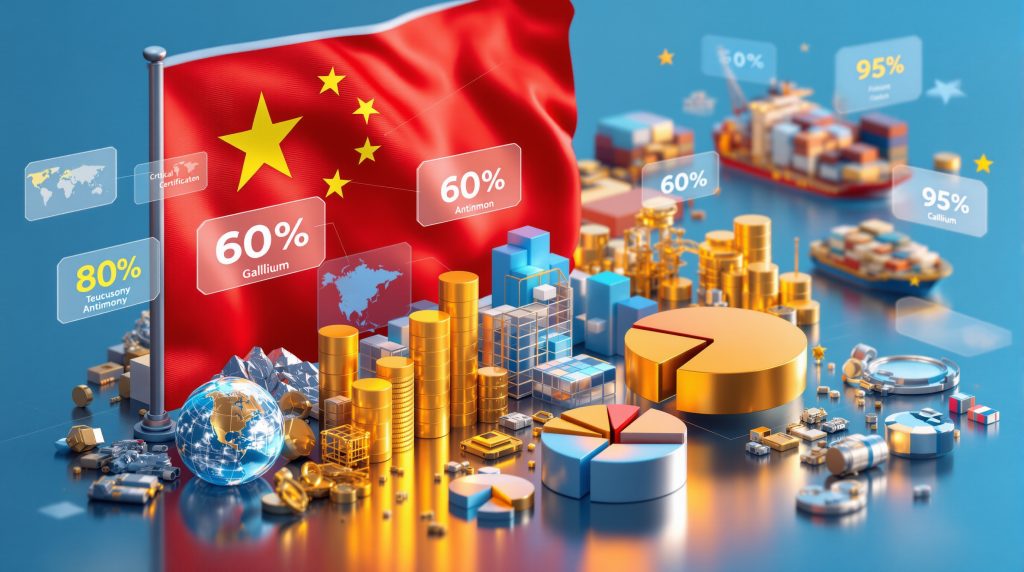Understanding China's Strategic Export Controls on Critical Metals
China's recent implementation of comprehensive export controls on tungsten, antimony, and silver represents a significant escalation in Beijing's strategic use of critical mineral access as geopolitical leverage. The Ministry of Commerce (MOFCOM) announced these new licensing requirements covering the 2026-2027 period, establishing stringent qualification criteria that effectively consolidate export privileges among established state-aligned companies while restricting market access for smaller operators. Furthermore, these China export rules rare metals policies demonstrate Beijing's systematic approach to leveraging resource dominance for strategic advantage.
The New Regulatory Framework for Metal Exports
The latest China export rules rare metals framework requires trading companies to demonstrate substantial financial credibility through rigorous credit threshold assessments. Companies must provide comprehensive documentation of their export activities spanning 2022-2024, proving their historical performance in international markets before gaining approval for future transactions.
According to data from Chinatungsten Online, China's tungsten exports declined 13.75% year-over-year during the January to September 2025 period, totaling approximately 12,000 tons. This reduction becomes particularly significant when considering China's commanding 80% share of global tungsten production, making even modest export adjustments highly impactful for downstream industries worldwide.
The qualification requirements include:
- Financial stability verification through detailed credit assessments
- Historical export volume documentation proving substantial trading activity
- Environmental compliance certification under resource protection mandates
- Integration capabilities within China's state trading system infrastructure
Strategic Implications Across Global Supply Chains
China's market dominance across critical metal sectors creates immediate downstream effects when export policies tighten. The tungsten market exemplifies this dynamic, where Chinese supply restrictions directly impact defense contractors requiring the metal for armor-piercing ammunition, semiconductor manufacturers dependent on high-purity tungsten compounds, and aerospace companies utilising specialised tungsten alloys in turbine applications.
Industry analysis reveals that antimony applications extend beyond traditional flame retardants into advanced battery technologies and electronic components, while silver maintains critical importance in solar panel manufacturing and high-conductivity electronic applications. Consequently, understanding these strategic antimony insights becomes crucial for assessing market impacts. Moreover, the silver market dynamics demonstrate how China's control over these supply chains enables Beijing to influence pricing mechanisms and availability across multiple industrial sectors simultaneously.
Geopolitical Motivations Behind Resource Control
The policy framework extends beyond stated environmental protection objectives to encompass broader national security considerations. This approach mirrors Beijing's 2023 restrictions on gallium and germanium exports, establishing a consistent pattern of leveraging critical mineral access during international trade negotiations. In addition, the US‑China trade impacts demonstrate how these restrictions serve broader geopolitical objectives.
Market participants recognise several strategic motivations driving these export controls:
- Supply chain leverage during bilateral and multilateral trade discussions
- Domestic industry protection through preferential resource allocation mechanisms
- Price stabilisation via controlled market supply management
- Technology transfer incentives encouraging foreign investment in Chinese processing facilities
Critical Metal Market Dynamics and Supply Concentrations
| Metal | Primary Applications | China's Market Share | 2025 Export Impact |
|---|---|---|---|
| Tungsten | Defence systems, semiconductors | 80% | 13.75% decline |
| Antimony | Flame retardants, battery tech | 60% | Licensing restrictions |
| Silver | Electronics, solar panels | 15% | New quota system |
| Gallium | Advanced semiconductors | 95% | Ongoing restrictions |
| Germanium | Fibre optics, infrared systems | 85% | Export limitations |
The concentration of processing capabilities within China creates systemic vulnerabilities for Western supply chains, even when raw materials originate from other geographic regions. Chinese refinement infrastructure has developed over decades of strategic investment, creating technical expertise and economies of scale that remain difficult to replicate rapidly elsewhere.
Alternative Supply Chain Development Challenges
Western nations are accelerating domestic mining initiatives and pursuing partnerships with non-Chinese suppliers to reduce dependency on Beijing's export decisions. However, establishing competitive refining capabilities requires substantial capital investment, typically ranging from $500 million to $2 billion for comprehensive processing facilities, along with multi-year development timelines. The critical raw materials supply challenge illustrates these complexities across European markets.
Current alternative supply initiatives include:
- North American tungsten projects targeting domestic defence industry requirements
- European-African mining partnerships developing antimony extraction capabilities
- Australian rare earth processing facility expansions incorporating critical metals
- Advanced recycling technologies for critical metal recovery from electronic waste
- Strategic stockpiling programmes by government agencies and major industrial consumers
Furthermore, Australia's defence materials strategy demonstrates how nations are responding to these supply chain vulnerabilities.
Market Price Dynamics and Investment Implications
Export restrictions create artificial scarcity conditions that historically drive significant price increases across affected commodities. Market analysis indicates that tungsten prices typically experience 15-30% volatility following Chinese policy announcements, while antimony markets show similar sensitivity to supply uncertainty.
The timing of China's export control announcements often coincides with Western supply chain diversification milestones, suggesting strategic coordination designed to maintain market influence during competitive transitions.
Investment themes emerging from these supply constraints include opportunities in alternative mining development, recycling technology advancement, and substitute material research. Companies developing tungsten and antimony projects outside China have attracted increased investor interest, though technical and regulatory challenges remain substantial.
Industrial Response Strategies and Risk Mitigation
Manufacturing companies dependent on Chinese critical metals are implementing comprehensive supply chain risk management strategies incorporating multiple sourcing options and strategic inventory management. Leading semiconductor manufacturers have increased their raw material reserves from typical 30-60 day supplies to 90-180 day buffers, while defence contractors are exploring alternative alloy compositions that reduce tungsten dependency.
Effective risk mitigation approaches include:
- Geographic diversification across multiple supplier regions and processing facilities
- Strategic inventory expansion for critical production inputs with long lead times
- Recycling capability investment to reduce virgin material dependency
- Substitute material development through dedicated research and development programmes
- Regulatory monitoring systems providing early warning of policy changes
Environmental Rhetoric Versus Strategic Reality
While Beijing consistently frames export restrictions as environmental protection measures, industry analysis suggests resource conservation serves primarily as policy justification for strategic trade management rather than genuine ecological motivation. According to recent analysis from the International Energy Agency, the selective application of environmental standards to export activities while maintaining high domestic production levels indicates prioritisation of geopolitical objectives over environmental concerns.
Technical assessment reveals that Chinese tungsten and antimony mining operations continue expanding to meet domestic demand, with environmental regulations applied differently to domestic consumption versus export activities. This dual-standard approach reinforces the strategic nature of export controls rather than comprehensive environmental policy implementation.
Long-term Implications for Global Metal Markets
China's systematic approach to critical metal export controls suggests a long-term strategy designed to maintain leverage over Western industrial capabilities while domestic Chinese industries receive preferential access to raw materials. This creates permanent structural advantages for Chinese manufacturers competing in global markets, particularly in high-technology sectors requiring specialised metal inputs.
Future policy evolution will likely depend on several key factors:
- Trade relationship dynamics with major importing nations and response measures
- Domestic economic priorities balancing export revenue against strategic objectives
- Western supply chain maturity potentially reducing Chinese market leverage over time
- International regulatory responses including potential reciprocal trade restrictions
Investment Opportunities in Alternative Supply Chains
China's tightening export controls create significant investment opportunities across alternative supply chain development, particularly in regions with established mining infrastructure and favourable regulatory environments. North American tungsten projects, Australian antimony development, and European recycling technologies represent emerging investment themes driven by supply security concerns.
Market analysis indicates that companies successfully developing non-Chinese critical metal supplies could achieve premium valuations due to supply chain security benefits for end-users. However, investors must carefully evaluate technical feasibility, regulatory approval timelines, and competitive positioning against established Chinese suppliers.
Technical Considerations for Metal Substitution
The unique properties of tungsten, antimony, and silver in specialised applications create technical challenges for material substitution strategies. Tungsten's exceptional density and melting point make it irreplaceable in certain defence and aerospace applications, while antimony's flame-retardant properties and silver's conductivity characteristics limit substitute material options.
Research into alternative materials focuses on composite solutions and alloy modifications that maintain performance characteristics while reducing dependency on restricted metals. However, qualification processes for substitute materials in critical applications typically require extensive testing periods spanning 2-5 years, limiting immediate supply chain flexibility.
How Will These Controls Impact Global Markets?
The effectiveness of China's China export rules rare metals strategy will ultimately depend on Western supply chain diversification progress and technological advances in material substitution. Current market indicators suggest that immediate price volatility will continue across affected commodities, with tungsten prices showing particular sensitivity to policy announcements.
What Are the Long-term Strategic Implications?
Beijing's systematic expansion of critical metal export controls suggests continued policy evolution targeting additional materials with strategic importance. Industry observers anticipate potential restrictions on lithium processing, cobalt refining, and other battery-critical materials as geopolitical tensions persist.
The effectiveness of China's resource leverage strategy will ultimately depend on Western supply chain diversification progress and technological advances in material substitution. While current alternative supply projects show promise, achieving meaningful independence from Chinese critical metal exports will require sustained investment and political commitment over the next decade.
Disclaimer: This analysis is for informational purposes only and should not be considered as investment advice. Critical metal markets involve significant risks including regulatory changes, geopolitical developments, and technical challenges that can substantially impact investment outcomes. Readers should conduct their own research and consult qualified professionals before making investment decisions.
Ready to Capitalise on China's Critical Metals Export Restrictions?
Discovery Alert's proprietary Discovery IQ model delivers real-time alerts on significant tungsten, antimony, and silver discoveries across ASX markets, instantly empowering subscribers to identify actionable opportunities ahead of broader market recognition of supply chain disruptions. Begin your 30-day free trial today and secure your market-leading advantage as global critical metals dynamics reshape investment landscapes.




